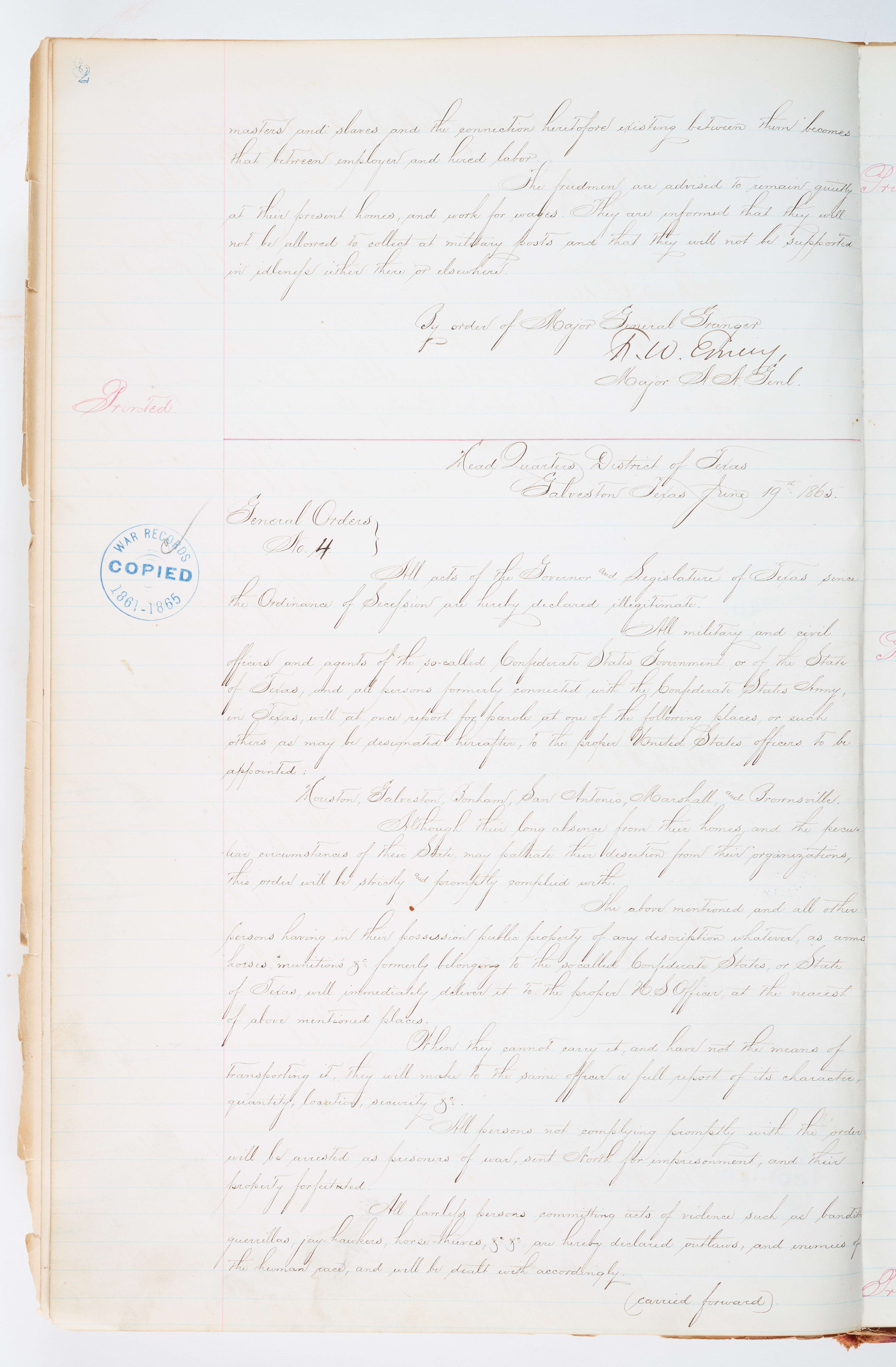All Slaves are Free: The Emancipation of Enslaved People
Focusing on Details: Compare and Contrast
All documents and text associated with this activity are printed below, followed by a worksheet for student responses.Introduction
President Abraham Lincoln issued the Emancipation Proclamation on January 1, 1863. A little over two years later, in February 1865, what would become the 13th Amendment to the U.S. Constitution was submitted to the state legislatures for ratification. On June 19, 1865, U.S. Major General Gordon Granger issued General Order No. 3.
Read and analyze these three documents. Note the similarities and differences in style, tone, intended audience, and message.
Name:
Class:
Class:
Worksheet
All Slaves are Free: The Emancipation of Enslaved People
Focusing on Details: Compare and Contrast
Examine the documents included in this activity and write your response in the space provided.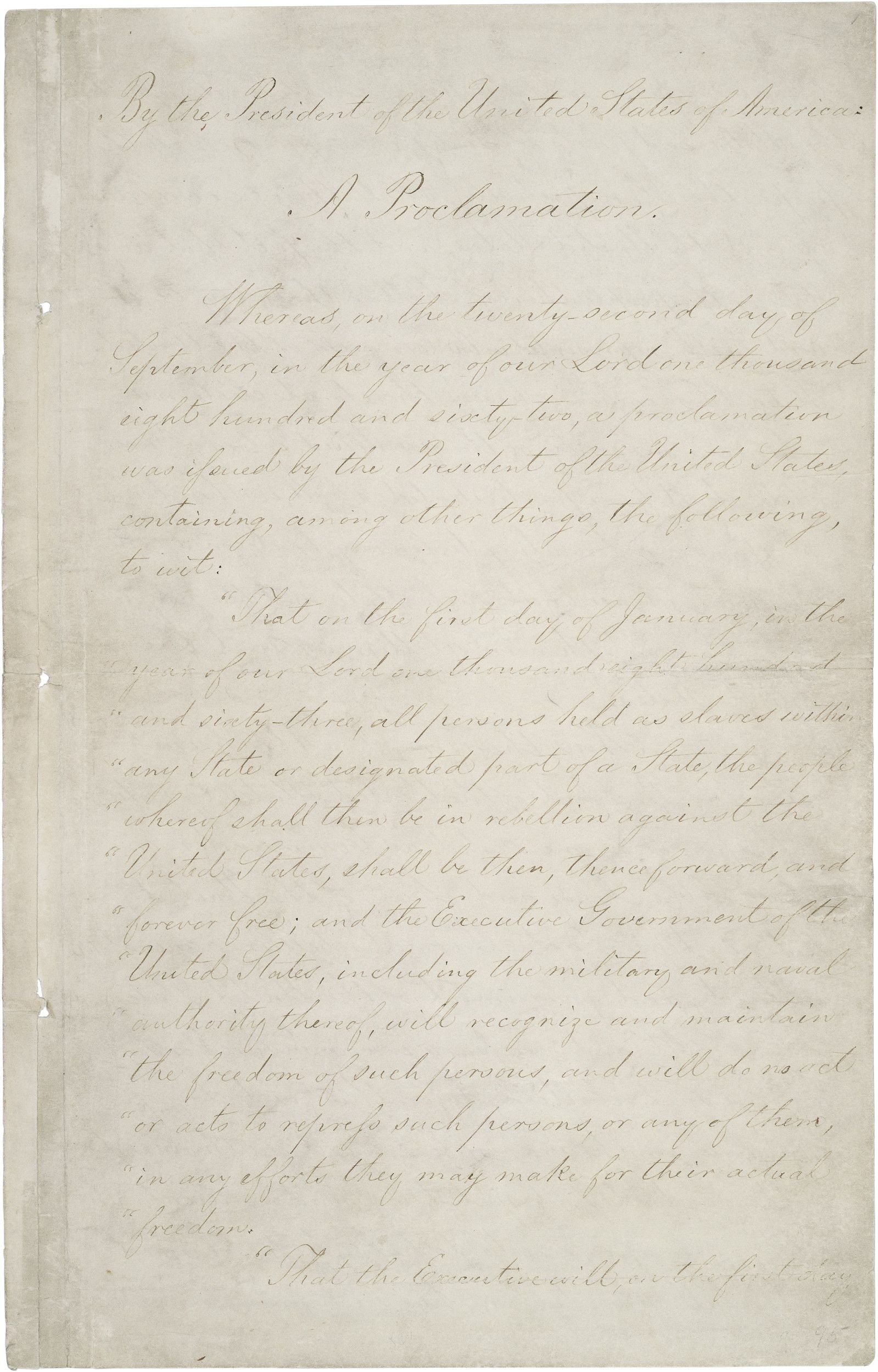

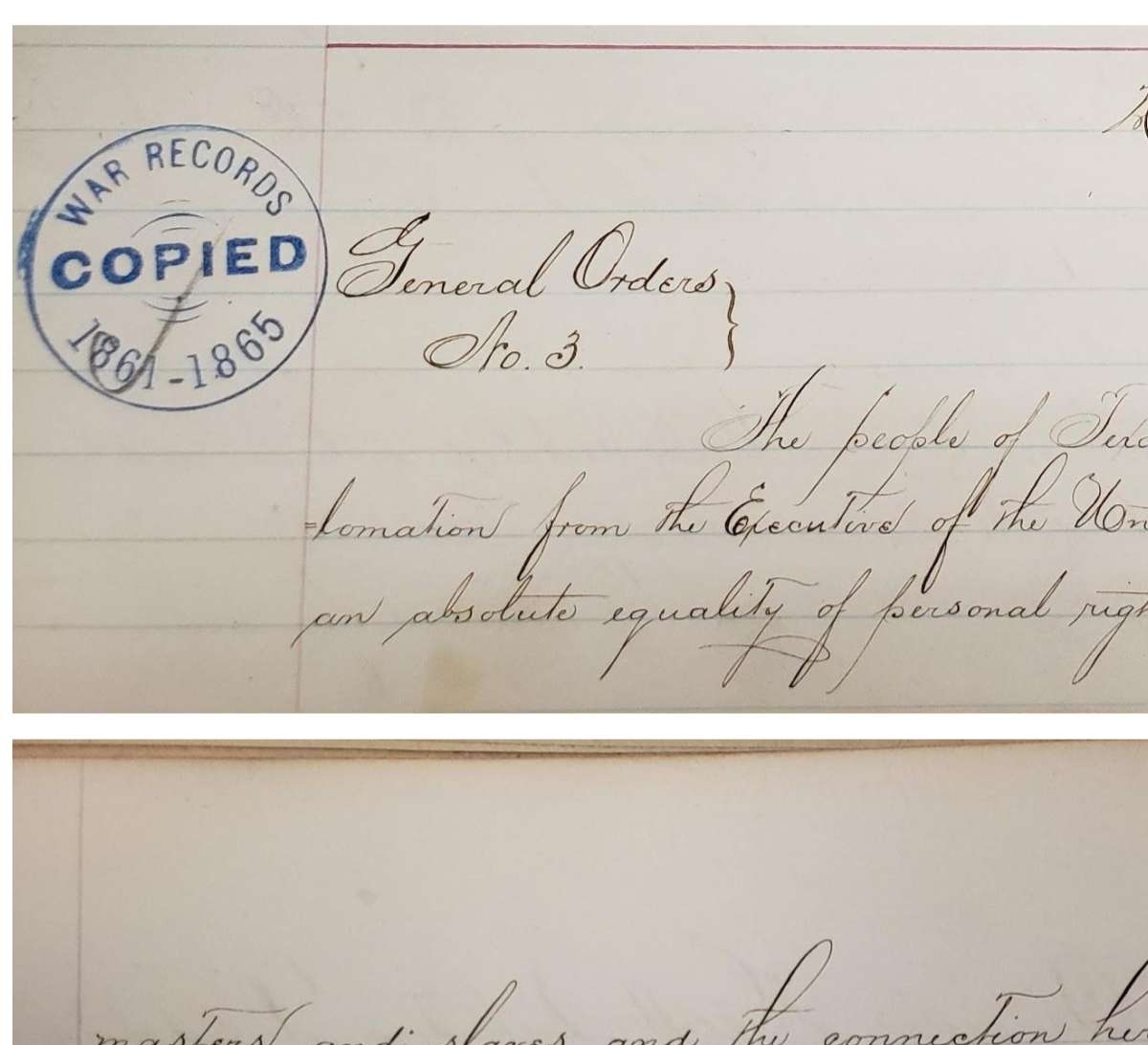
For each of the documents, answer the following questions:
- What is the main message of the document?
- Describe the overall tone and style of the document.
- Who is the intended audience for the document?
- How does it describe enslaved people and their freedom?
- What does it tell enslaved people to do?
- In what areas of the United States does it apply?
Your Response
1
Activity Element
Emancipation Proclamation

2
Activity Element
Joint Resolution Proposing the Thirteenth Amendment to the United States Constitution

3
Activity Element
General Order No. 3, issued by Maj. Gen. Gordon Granger

Conclusion
All Slaves are Free: The Emancipation of Enslaved People
Focusing on Details: Compare and Contrast
- Which document do you think is the most important in freeing enslaved people? Explain.
Your Response
Document
Emancipation Proclamation
1/1/1863
President Abraham Lincoln issued the Emancipation Proclamation on January 1, 1863, announcing, "that all persons held as slaves" within the rebellious areas "are, and henceforward shall be free."
Initially, the Civil War between North and South was fought by the North to prevent the secession of the Southern states and preserve the Union. Even though sectional conflicts over slavery had been a major cause of the war, ending slavery was not a goal of the war. That changed on September 22, 1862, when President Lincoln issued his Preliminary Emancipation Proclamation, which stated that enslaved people in those states or parts of states still in rebellion as of January 1, 1863, would be declared free. One hundred days later, with the rebellion unabated, President issued the Emancipation Proclamation declaring "that all persons held as slaves" within the rebellious areas "are, and henceforward shall be free."
Lincoln’s bold step to change the goals of the war was a military measure and came just a few days after the Union’s victory in the Battle of Antietam. With this Proclamation he hoped to inspire all Black people, and enslaved people in the Confederacy in particular, to support the Union cause and to keep England and France from giving political recognition and military aid to the Confederacy.
Because it was a military measure, however, the Emancipation Proclamation was limited in many ways. It applied only to states that had seceded from the Union, leaving slavery untouched in the loyal border states. It also expressly exempted parts of the Confederacy that had already come under Union control. Most important, the freedom it promised depended upon Union military victory.
Although the Emancipation Proclamation did not end slavery in the nation, it did fundamentally transform the character of the war. After January 1, 1863, every advance of Federal troops expanded the domain of freedom. Moreover, the Proclamation announced the acceptance of Black men into the Union Army and Navy, enabling the liberated to become liberators. By the end of the war, almost 200,000 Black soldiers and sailors had fought for the Union and freedom.
From the first days of the Civil War, enslaved people had acted to secure their own liberty. The Emancipation Proclamation confirmed their insistence that the war for the Union must become a war for freedom. It added moral force to the Union cause and strengthened the Union both militarily and politically. As a milestone along the road to slavery's final destruction, the Emancipation Proclamation has assumed a place among the great documents of human freedom.
Initially, the Civil War between North and South was fought by the North to prevent the secession of the Southern states and preserve the Union. Even though sectional conflicts over slavery had been a major cause of the war, ending slavery was not a goal of the war. That changed on September 22, 1862, when President Lincoln issued his Preliminary Emancipation Proclamation, which stated that enslaved people in those states or parts of states still in rebellion as of January 1, 1863, would be declared free. One hundred days later, with the rebellion unabated, President issued the Emancipation Proclamation declaring "that all persons held as slaves" within the rebellious areas "are, and henceforward shall be free."
Lincoln’s bold step to change the goals of the war was a military measure and came just a few days after the Union’s victory in the Battle of Antietam. With this Proclamation he hoped to inspire all Black people, and enslaved people in the Confederacy in particular, to support the Union cause and to keep England and France from giving political recognition and military aid to the Confederacy.
Because it was a military measure, however, the Emancipation Proclamation was limited in many ways. It applied only to states that had seceded from the Union, leaving slavery untouched in the loyal border states. It also expressly exempted parts of the Confederacy that had already come under Union control. Most important, the freedom it promised depended upon Union military victory.
Although the Emancipation Proclamation did not end slavery in the nation, it did fundamentally transform the character of the war. After January 1, 1863, every advance of Federal troops expanded the domain of freedom. Moreover, the Proclamation announced the acceptance of Black men into the Union Army and Navy, enabling the liberated to become liberators. By the end of the war, almost 200,000 Black soldiers and sailors had fought for the Union and freedom.
From the first days of the Civil War, enslaved people had acted to secure their own liberty. The Emancipation Proclamation confirmed their insistence that the war for the Union must become a war for freedom. It added moral force to the Union cause and strengthened the Union both militarily and politically. As a milestone along the road to slavery's final destruction, the Emancipation Proclamation has assumed a place among the great documents of human freedom.
Transcript
By the President of the United States of America:A Proclamation.
Whereas, on the twenty-second day of September, in the year of our Lord one thousand eight hundred and sixty-two, a proclamation was issued by the President of the United States, containing, among other things, the following, to wit:
"That on the first day of January, in the year of our Lord one thousand eight hundred and sixty-three, all persons held as slaves within any State or designated part of a State, the people whereof shall then be in rebellion against the United States, shall be then, thenceforward, and forever free; and the Executive Government of the United States, including the military and naval authority thereof, will recognize and maintain the freedom of such persons, and will do no act or acts to repress such persons, or any of them, in any efforts they may make for their actual freedom.
"That the Executive will, on the first day of January aforesaid, by proclamation, designate the States and parts of States, if any, in which the people thereof, respectively, shall then be in rebellion against the United States; and the fact that any State, or the people thereof, shall on that day be, in good faith, represented in the Congress of the United States by members chosen thereto at elections wherein a majority of the qualified voters of such State shall have participated, shall, in the absence of strong countervailing testimony, be deemed conclusive evidence that such State, and the people thereof, are not then in rebellion against the United States."
Now, therefore I, Abraham Lincoln, President of the United States, by virtue of the power in me vested as Commander-in-Chief, of the Army and Navy of the United States in time of actual armed rebellion against the authority and government of the United States, and as a fit and necessary war measure for suppressing said rebellion, do, on this first day of January, in the year of our Lord one thousand eight hundred and sixty-three, and in accordance with my purpose so to do publicly proclaimed for the full period of one hundred days, from the day first above mentioned, order and designate as the States and parts of States wherein the people thereof respectively, are this day in rebellion against the United States, the following, to wit:
Arkansas, Texas, Louisiana, (except the Parishes of St. Bernard, Plaquemines, Jefferson, St. John, St. Charles, St. James Ascension, Assumption, Terrebonne, Lafourche, St. Mary, St. Martin, and Orleans, including the City of New Orleans) Mississippi, Alabama, Florida, Georgia, South Carolina, North Carolina, and Virginia, (except the forty-eight counties designated as West Virginia, and also the counties of Berkley, Accomac, Northampton, Elizabeth City, York, Princess Ann, and Norfolk, including the cities of Norfolk and Portsmouth[)], and which excepted parts, are for the present, left precisely as if this proclamation were not issued.
And by virtue of the power, and for the purpose aforesaid, I do order and declare that all persons held as slaves within said designated States, and parts of States, are, and henceforward shall be free; and that the Executive government of the United States, including the military and naval authorities thereof, will recognize and maintain the freedom of said persons.
And I hereby enjoin upon the people so declared to be free to abstain from all violence, unless in necessary self-defence; and I recommend to them that, in all cases when allowed, they labor faithfully for reasonable wages.
And I further declare and make known, that such persons of suitable condition, will be received into the armed service of the United States to garrison forts, positions, stations, and other places, and to man vessels of all sorts in said service.
And upon this act, sincerely believed to be an act of justice, warranted by the Constitution, upon military necessity, I invoke the considerate judgment of mankind, and the gracious favor of Almighty God.
In witness whereof, I have hereunto set my hand and caused the seal of the United States to be affixed.
Done at the City of Washington, this first day of January, in the year of our Lord one thousand eight hundred and sixty three, and of the Independence of the United States of America the eighty-seventh.
By the President: ABRAHAM LINCOLN
WILLIAM H. SEWARD, Secretary of State.
This primary source comes from the General Records of the United States Government.
National Archives Identifier: 299998
Full Citation: Emancipation Proclamation; 1/1/1863; Presidential Proclamations, 1791 - 2011; General Records of the United States Government, ; National Archives Building, Washington, DC. [Online Version, https://docsteach.org/documents/document/emancipation-proclamation, April 16, 2024]Emancipation Proclamation
Page 1
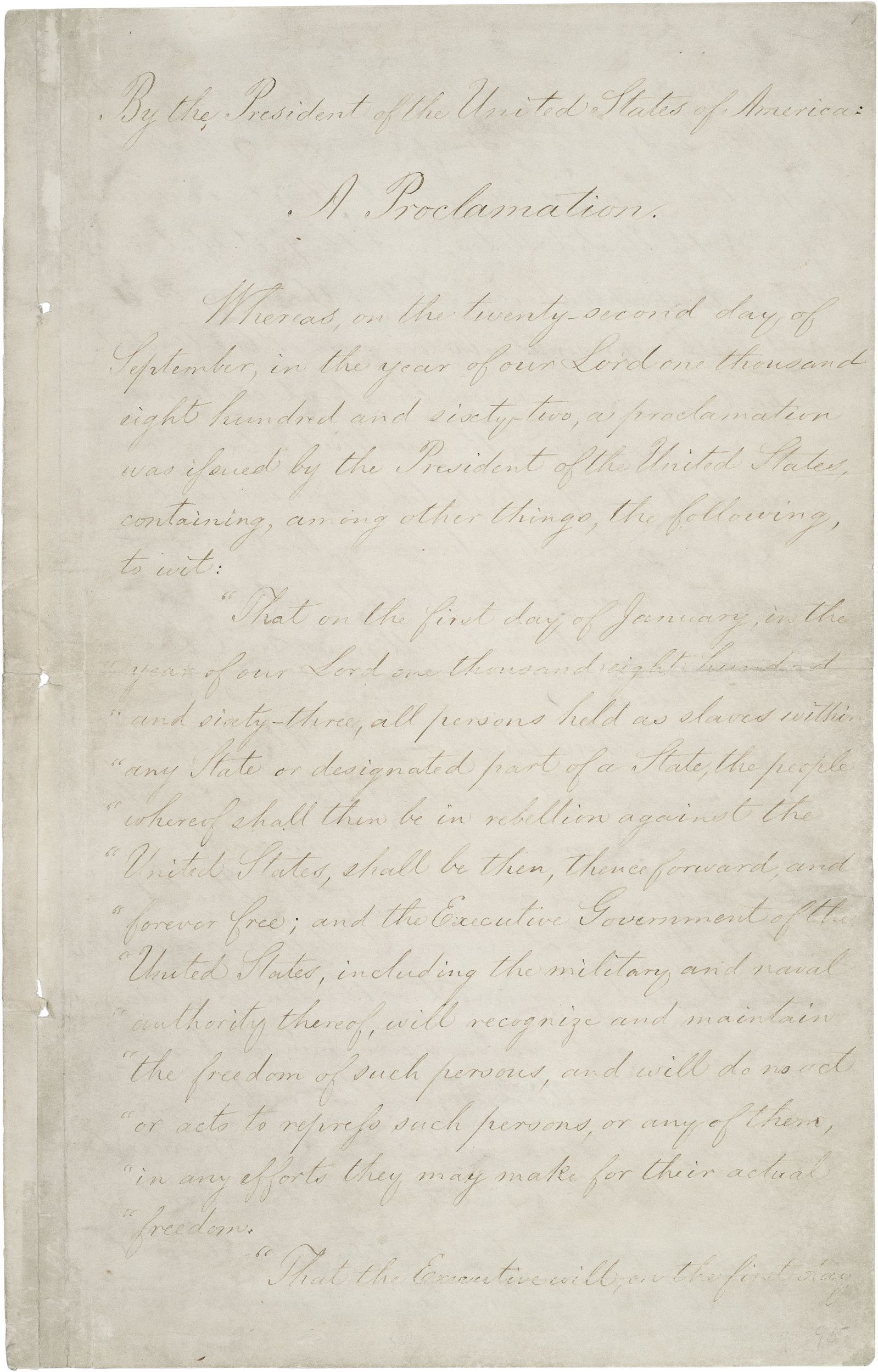
Emancipation Proclamation
Page 2
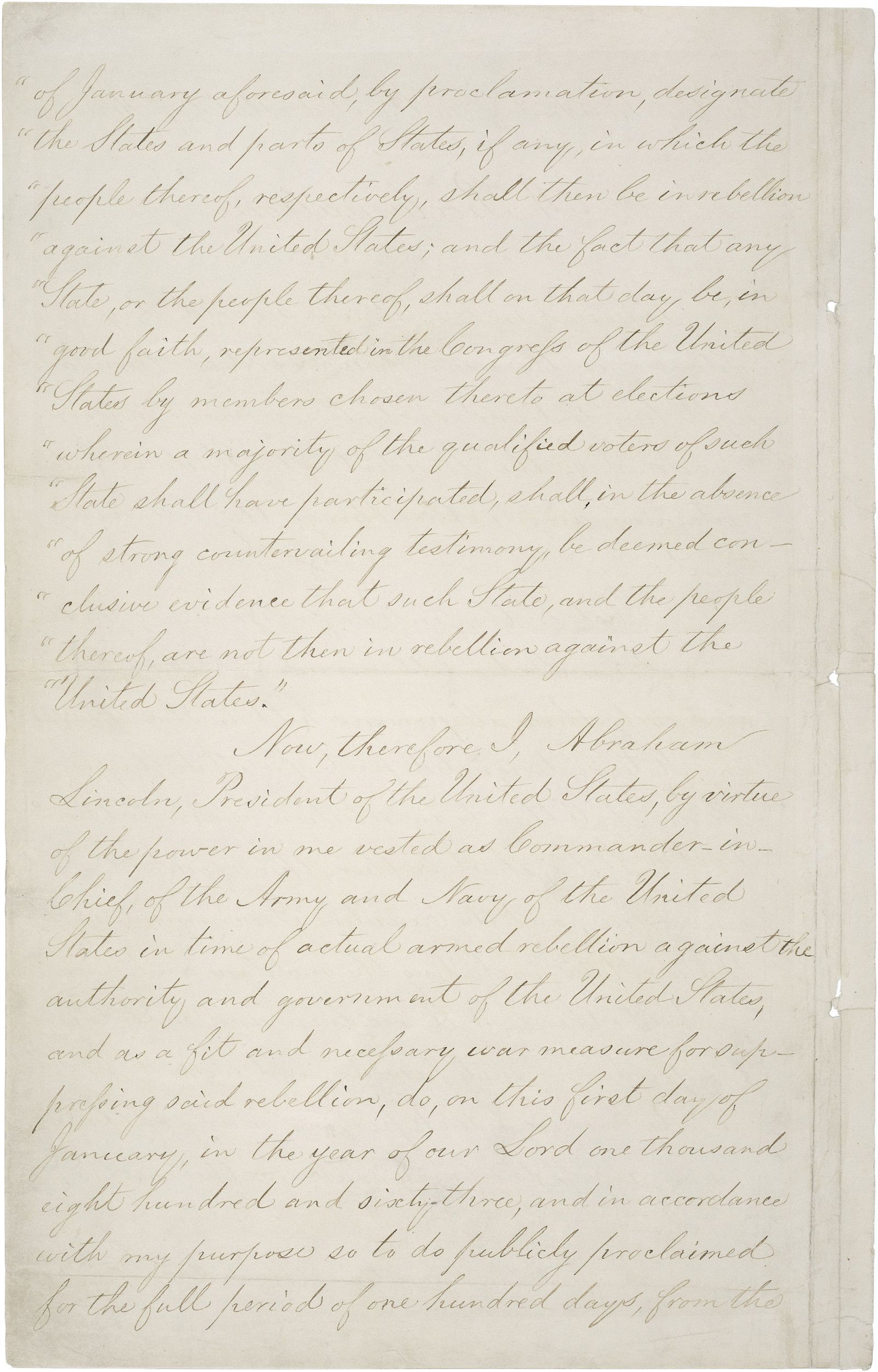
Emancipation Proclamation
Page 3

Emancipation Proclamation
Page 4
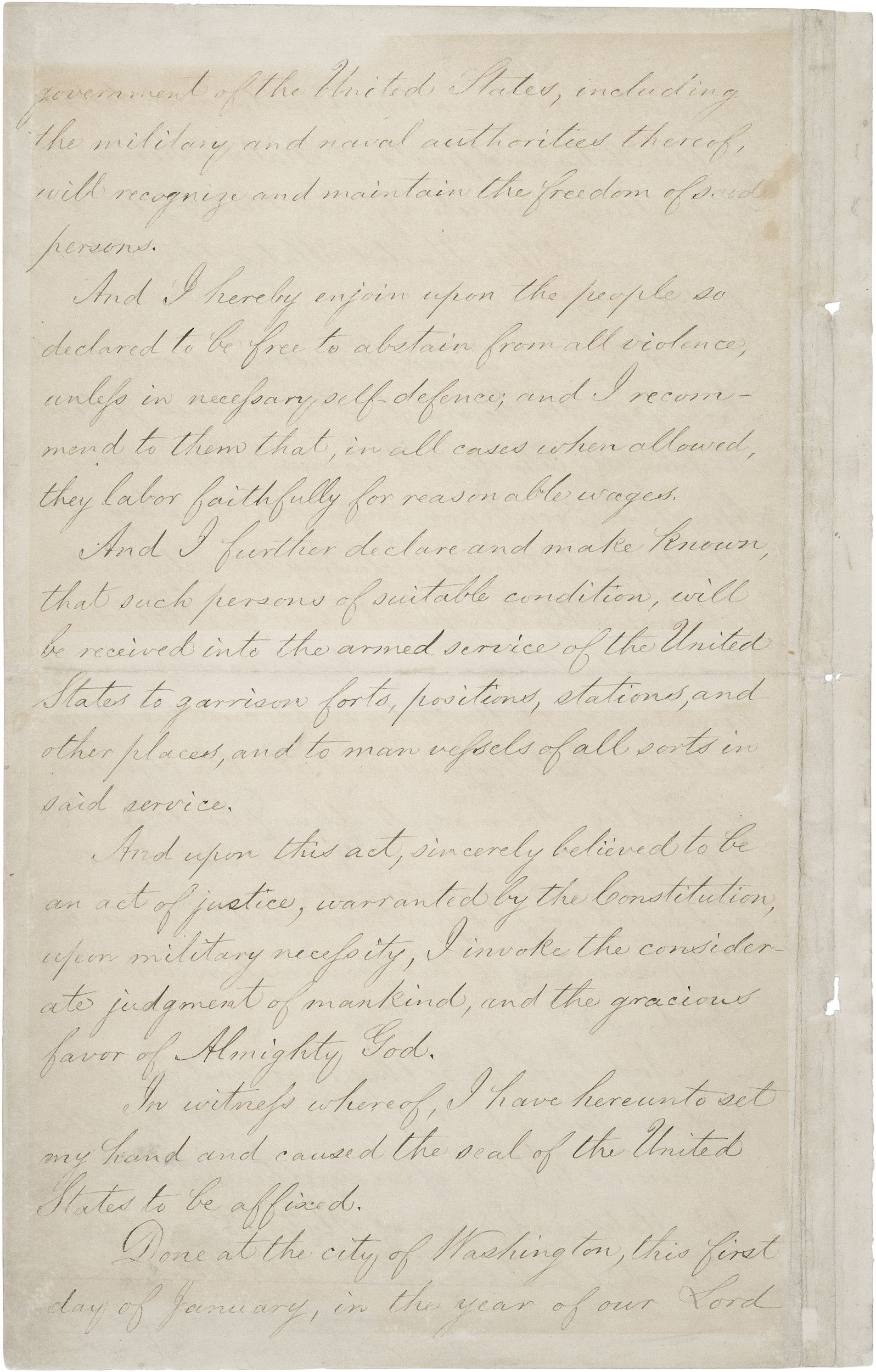
Emancipation Proclamation
Page 5
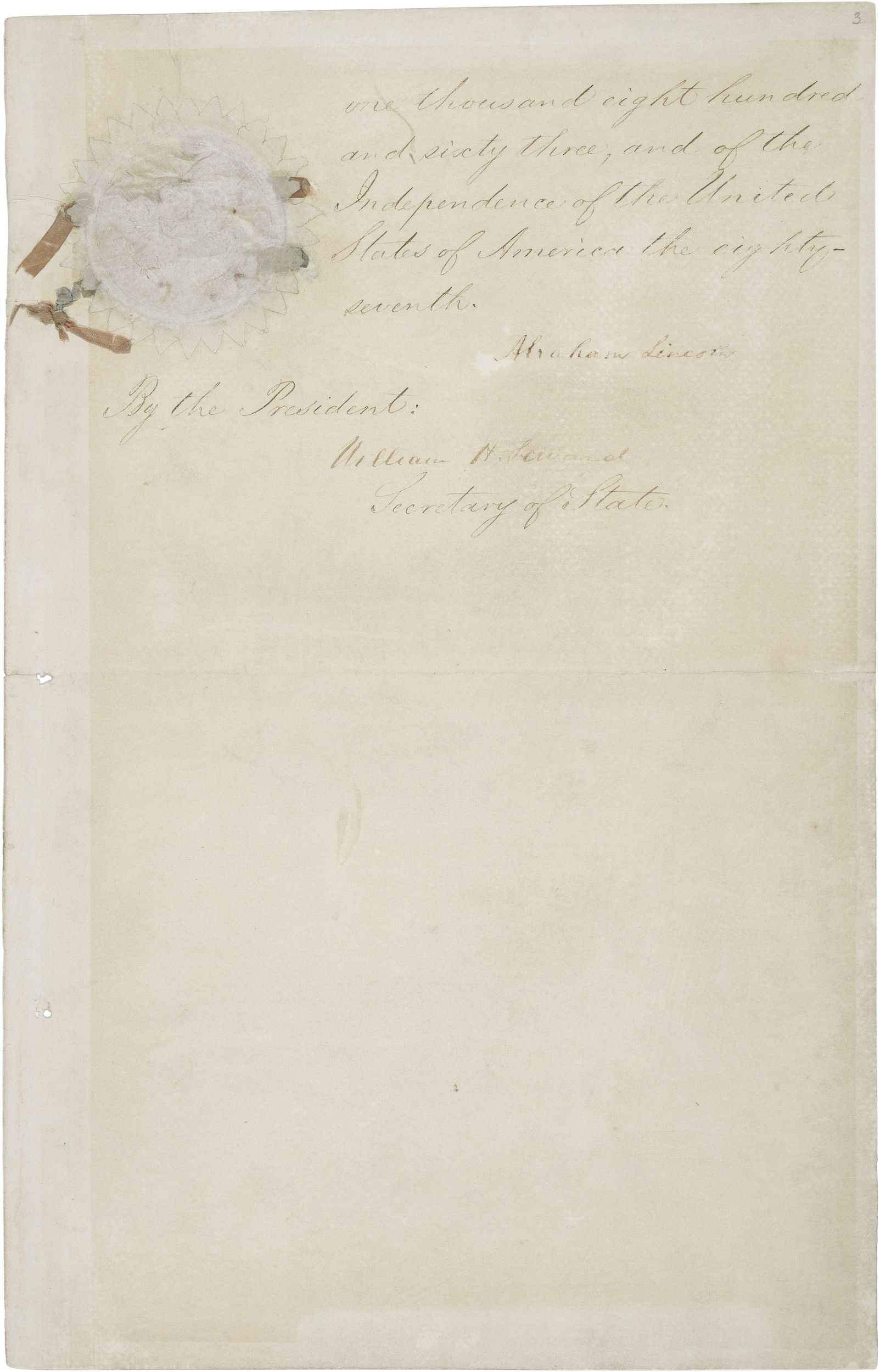
Document
Joint Resolution Proposing the Thirteenth Amendment to the United States Constitution
1/31/1865
This is a draft of a joint resolution proposing the 13th Amendment to the United States Constitution that started in the Senate. A joint resolution is a formal opinion adopted by both houses of the legislative branch. A constitutional amendment must be passed as a joint resolution before it is sent to the states for ratification. This particular resolution became the 13th Amendment, ending slavery in the United States in 1865.
In 1863, President Lincoln had issued the Emancipation Proclamation declaring “all persons held as slaves within any State, or designated part of a State, the people whereof shall then be in rebellion against the United States, shall be then, thenceforward, and forever free.” Nonetheless, the Emancipation Proclamation did not end slavery in the nation since it only applied to areas of the Confederacy currently in a state of rebellion (and not even to the loyal “border states” that remained in the Union). Lincoln recognized that the Emancipation Proclamation would have to be followed by a constitutional amendment in order to guarantee the abolishment of slavery.
The 13th Amendment was passed at the end of the Civil War before the Southern states had been restored to the Union, and should have easily passed in Congress. However, though the Senate passed it in April 1864, the House initially did not. At that point, Lincoln took an active role to ensure passage through Congress. He insisted that passage of the 13th Amendment be added to the Republican Party platform for the upcoming 1864 Presidential election. His efforts met with success when the House passed the bill in January 1865 with a vote of 119–56.
On February 1, 1865, President Abraham Lincoln approved the Joint Resolution of Congress submitting the proposed amendment to the state legislatures. The necessary number of states (three-fourths) ratified it by December 6, 1865. The 13th Amendment to the United States Constitution provides that "Neither slavery nor involuntary servitude, except as a punishment for crime whereof the party shall have been duly convicted, shall exist within the United States, or any place subject to their jurisdiction."
With the adoption of the 13th Amendment, the United States found a final constitutional solution to the issue of slavery. The 13th Amendment, along with the 14th and 15th, is one of the trio of Civil War amendments that greatly expanded the civil rights of Americans.
In 1863, President Lincoln had issued the Emancipation Proclamation declaring “all persons held as slaves within any State, or designated part of a State, the people whereof shall then be in rebellion against the United States, shall be then, thenceforward, and forever free.” Nonetheless, the Emancipation Proclamation did not end slavery in the nation since it only applied to areas of the Confederacy currently in a state of rebellion (and not even to the loyal “border states” that remained in the Union). Lincoln recognized that the Emancipation Proclamation would have to be followed by a constitutional amendment in order to guarantee the abolishment of slavery.
The 13th Amendment was passed at the end of the Civil War before the Southern states had been restored to the Union, and should have easily passed in Congress. However, though the Senate passed it in April 1864, the House initially did not. At that point, Lincoln took an active role to ensure passage through Congress. He insisted that passage of the 13th Amendment be added to the Republican Party platform for the upcoming 1864 Presidential election. His efforts met with success when the House passed the bill in January 1865 with a vote of 119–56.
On February 1, 1865, President Abraham Lincoln approved the Joint Resolution of Congress submitting the proposed amendment to the state legislatures. The necessary number of states (three-fourths) ratified it by December 6, 1865. The 13th Amendment to the United States Constitution provides that "Neither slavery nor involuntary servitude, except as a punishment for crime whereof the party shall have been duly convicted, shall exist within the United States, or any place subject to their jurisdiction."
With the adoption of the 13th Amendment, the United States found a final constitutional solution to the issue of slavery. The 13th Amendment, along with the 14th and 15th, is one of the trio of Civil War amendments that greatly expanded the civil rights of Americans.
Transcript
Thirty-Eighth Congress of the United StatesAt the Second Session
Begun and held at the City of Washington, on Monday, the fifth day of December, one thousand eight hundred and sixty-four
A Resolution
Submitting to the legislatures of the several States a proposition to amend the Constitution of the United States.
Resolved by the Senate and House of Representatives of the United States of America in Congress assembled,
(two-thirds of both houses concurring), that the following article be proposed to the legislatures of the several states as an amendment to the Constitution of the United States, which, when ratified by three-fourths of said Legislatures shall be
valid, to all intents and purposes, as part of the said Constitution, namely: Article XIII. Section 1. Neither slavery nor involuntary servitude, except as a punishment for crime whereof the party shall have been duly convicted, shall exist within the United States, or any place subject to their jurisdiction. Section 2. Congress shall have power to enforce this article by appropriate legislation.
Schuyler Colfax
Speaker of the House of Representatives
Hannibal Hamlin
Vice President of the United States
and President of the Senate
Approved February 1, 1865 Abraham Lincoln
This primary source comes from the General Records of the United States Government.
National Archives Identifier: 1408764
Full Citation: Joint Resolution Proposing the Thirteenth Amendment to the United States Constitution; 1/31/1865; Enrolled Acts and Resolutions of Congress, 1789 - 2011; General Records of the United States Government, ; National Archives Building, Washington, DC. [Online Version, https://docsteach.org/documents/document/thirteenth-amendment, April 16, 2024]Joint Resolution Proposing the Thirteenth Amendment to the United States Constitution
Page 2
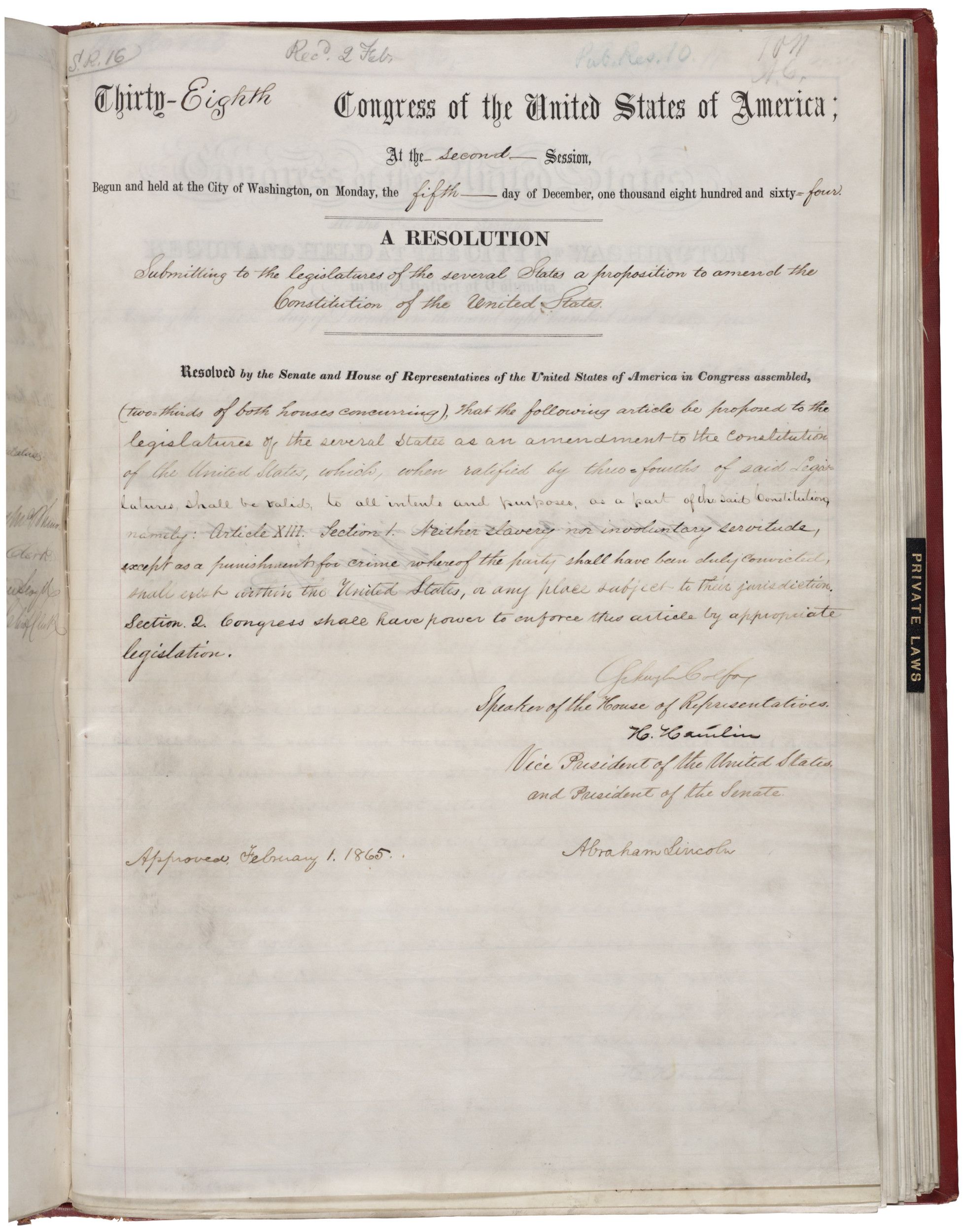
Document
General Order No. 3, issued by Maj. Gen. Gordon Granger
6/19/1865
On June 19, 1865, two and a half years after President Abraham Lincoln’s historic Emancipation Proclamation, U.S. Maj. Gen. Gordon Granger issued General Order No. 3, which informed the people of Texas that all enslaved people were now free. Granger commanded the Headquarters District of Texas, and his troops had arrived in Galveston the previous day.
This order represents the Federal Government’s final execution and fulfillment of the terms of the Emancipation Proclamation. The people to whom this order was addressed were the last group of Americans to be informed that all formerly enslaved persons were now free.
The effects of this order would later be celebrated as the "Juneteenth" holiday, a combination of June and nineteenth. It is also called Freedom Day or Emancipation Day, and it is the oldest known celebration commemorating the end of slavery in the United States.
This order represents the Federal Government’s final execution and fulfillment of the terms of the Emancipation Proclamation. The people to whom this order was addressed were the last group of Americans to be informed that all formerly enslaved persons were now free.
The effects of this order would later be celebrated as the "Juneteenth" holiday, a combination of June and nineteenth. It is also called Freedom Day or Emancipation Day, and it is the oldest known celebration commemorating the end of slavery in the United States.
Transcript
Headquarters District of Texas
Galveston Texas June 19th 1865
General Orders
No. 3
The people of Texas are informed that, in accordance with a proclamation from the Executive of the United States, all slaves are free. This involves an absolute equality of personal rights and rights of property between former masters and slaves, and the connection heretofore existing between them becomes that between employer and hired labor.
The freedmen are advised to remain quietly at their present homes and work for wages. They are informed that they will not be allowed to collect at military posts and that they will not be supported in idleness either there or elsewhere.
By order of Major General Granger
F.W. EMERY
Major A.A.Genl
This primary source comes from the Records of U.S. Army Continental Commands.
National Archives Identifier: 182778372
Full Citation: General Order No. 3, issued by Maj. Gen. Gordon Granger; 6/19/1865; General Orders Issued; General Orders Issued, 6/1865 - 7/1865; Records of U.S. Army Continental Commands, ; National Archives Building, Washington, DC. [Online Version, https://docsteach.org/documents/document/juneteenth-order, April 16, 2024]General Order No. 3, issued by Maj. Gen. Gordon Granger
Page 1
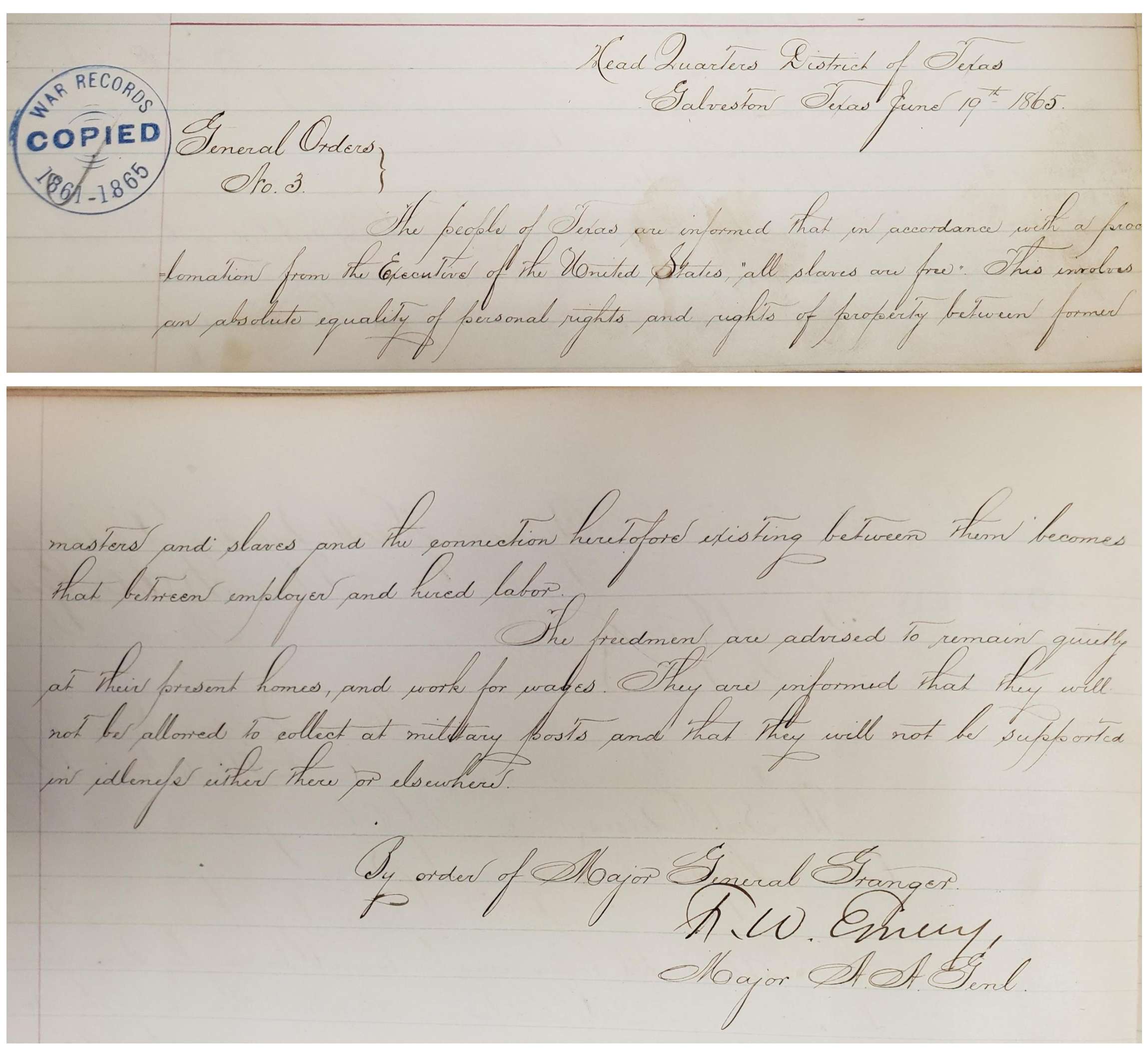
General Order No. 3, issued by Maj. Gen. Gordon Granger
Page 2
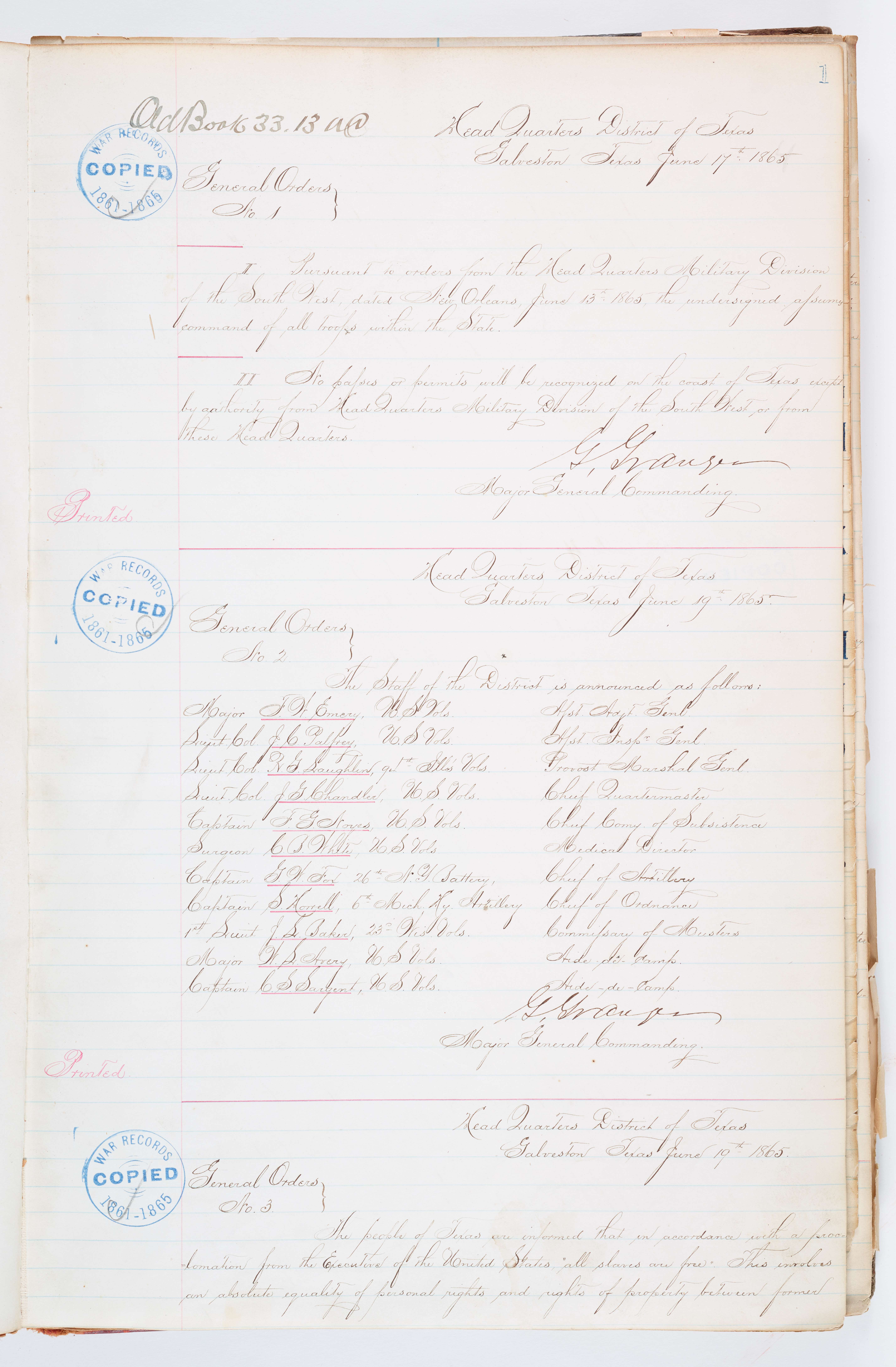
General Order No. 3, issued by Maj. Gen. Gordon Granger
Page 3
